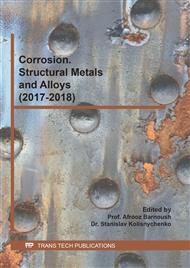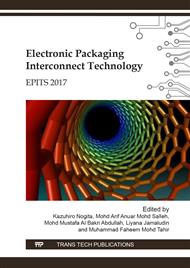[1]
M. Yang, H. Ji, S. Wang, Y.-H. Ko, C.-W. Lee, J. Wu, et al., J. of Alloys and Comp., vol. 679, pp.18-25, (2016).
Google Scholar
[2]
U. S. Mohanty and K.-L. Lin, Corr. Sci., vol. 50, pp.2437-2443, (2008).
Google Scholar
[3]
D. Li, P. P. Conway, and C. Liu, Corr. Sci., vol. 50, pp.995-1004, 4// (2008).
Google Scholar
[4]
Spotak Martin, Marian Drienovsky, T. Lydia, and P. Marian, presented at the Metal 2015, Czech Republic, EU, (2015).
Google Scholar
[5]
A. Wierzbicka-Miernik, J. Guspiel, and L. Zabdyr, Archives of Civil and Mecha. Eng., vol. 15, pp.206-213, (2015).
DOI: 10.1016/j.acme.2014.03.003
Google Scholar
[6]
W. R. Osorio, D. R. Leiva, L. C. Peixoto, L. R. Garcia, and A. Garcia,J. of Alloys and Comp., vol. 562, pp.194-204, (2013).
Google Scholar
[7]
L. Gao, S. Xue, L. Zhang, Z. Sheng, F. Ji, W. Dai, et al., Microelec. Eng., vol. 87, pp.2025-2034, (2010).
Google Scholar
[8]
M. F. M. Nazeri and A. A. Mohamad, Measurement, vol. 47, pp.820-826, (2014).
Google Scholar
[9]
E. S. Freitas, W. R. Osório, J. E. Spinelli, and A. Garcia, Microelect. Reliability, vol. 54, pp.1392-1400, (2014).
Google Scholar
[10]
F. Rosalbino, E. Angelini, G. Zanicchi, and R. Marazza, Mater. Chem. and Phy., vol. 109, pp.386-391, (2008).
Google Scholar
[11]
W. R. Osorio, L. C. Peixoto, L. R. Garcia, A. Garcia, and J. E. Spinelli, Inter. J. of Electrochem. Sci., vol. 7, p.6436, (2012).
Google Scholar
[12]
M. F. M. Nazeri and A. A. Mohamad, Measurement, vol. 47, pp.820-826, 1// (2014).
Google Scholar
[13]
F. Rosalbino, E. Angelini, G. Zanicchi, R. Carlini, and R. Marazza, Electrochimica Acta, vol. 54, pp.7231-7235, (2009).
DOI: 10.1016/j.electacta.2009.07.030
Google Scholar
[14]
K. Kim, S. Huh, and K. Suganuma, Microelectronics Reliability, vol. 43, pp.259-267, (2003).
Google Scholar
[15]
L. Mei Lee, M. Firdaus Mohd Nazeri, H. Haliman, and A. Azmin Mohamad, Soldering & Surface Mount Techno., vol. 26, pp.79-86, (2014).
DOI: 10.1108/ssmt-01-2013-0001
Google Scholar
[16]
M. C. Liew, I. Ahmad, L. M. Lee, M. F. M. Nazeri, H. Haliman, and A. A. Mohamad, Metallurgi. and Mater. Trans. A, vol. 43, pp.3742-3747, (2012).
Google Scholar
[17]
E. Efzan and A. Marini, Inter. J. of Eng., vol. 1, pp.2305-8269, (2012).
Google Scholar
[18]
M. Fayeka, A. Haseeb, and M. Fazal, Sains Malaysiana, vol. 46, pp.295-302, (2017).
Google Scholar
[19]
C. W. See, M. Z. Yahaya, H. Haliman, and A. A. Mohamad, Procedia Chem., vol. 19, pp.847-854, (2016).
Google Scholar



